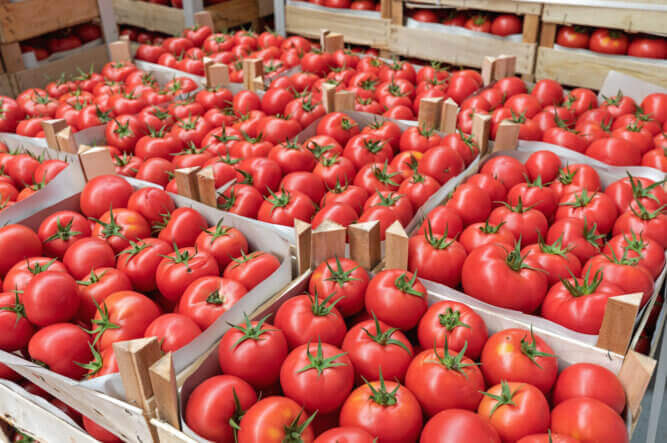How Harvest Season Impacts Carrier Availability

What are you waiting for?
Make more money starting now.
When you’re shipping fresh produce, time isn’t on your side. During harvest season, securing carriers quickly is essential. Already operating at full capacity, finding one with available trucks can be a challenge.
Understanding how the harvest season affects truckers can help you determine when scheduling your deliveries may be challenging. Find out what you need to know about harvest season and when the demand for truckers may be sky-high.
When is harvest season in trucking?
The harvest seasons are some of the busiest and most demanding times for truckers. Understanding these peak periods can help you anticipate when drivers are operating at full capacity, and finding one with available trucks can be difficult.
Spring (March – May)
Produce season kicks into high gear as spring rolls around, transforming the freight shipping sector after a few relatively quiet months. Freight volumes begin to pick up, giving carriers more loads to choose from and allowing them to be more selective. Shippers often find it more challenging to secure trucks, leading to rising rates, especially as reefer carriers gravitate towards high-paying produce loads.
In the spring, specific regions see substantial activity. You’ll see significant spikes in produce import volume from Mexico in Texas border cities, making outbound shipments highly lucrative for carriers. In Florida, Miami, Jacksonville, and Tampa contribute to a surge in outbound volume, causing rates to spike on lanes out of the state. California’s Central Valley also becomes a major outbound hub for early spring crops such as leafy greens and citrus, adding to the busy schedule for truckers during this season.
Summer (June – August)
Freight volumes peak in the summer, and rates continue to rise. In early summer, the Southeast region — including Georgia, the Carolinas, Mississippi, and Alabama — becomes a hotspot for apples, peaches, sweet potatoes, and eggplant. As the season progresses, Northern California produces apples, avocados, broccoli, and oranges. In Oregon and Washington, berries, cherries, apples, and pears keep truckers busy and on the move throughout the summer months.
Fall (September – November)
The weather cools by September, and the harvest season officially begins in the Midwest and Northeast. These regions experience some of the highest produce hauling rates.
In the Midwest, demand increases for hauling pumpkins, apples, cranberries, and sweet corn. Meanwhile, the Northeast creates demand for pumpkin, grape, cranberry, and fennel shipments.
Additional charges that may apply
Several additional charges may apply when shipping freight during harvest season. These fees — known as accessorial charges — can significantly increase the cost of shipping.
Here are the top five charges to be aware of:
- Truck order not used (TONU)
Carriers might charge a TONU fee if an order is canceled within a predetermined window as compensation for their time and resources. Harvests sometimes happen differently than planned, and you may need to cancel a carrier order occasionally, so ask about this fee when negotiating with carriers. - Detention charges
A driver stuck at the loading or unloading dock for an extended period through no fault of their own may charge you for detention. Typically, drivers offer a two-hour grace period before these hourly fees kick in, but this can vary. Negotiating detention charges before signing the contract is advisable to prevent surprise costs on your invoice. - Layover charges
A layover charge applies when a driver has to wait for at least 24 hours due to delays in loading or unloading. This fee, usually a flat rate, covers the driver’s inconvenience and the carrier or broker’s need to reschedule other deliveries. Layover charges can be expensive, so it is important to minimize delays whenever possible. - Deadhead miles
Deadhead miles are incurred when an empty truck returns to its point of origin or drives to a pickup location. While not all carriers charge for deadhead miles, ask about this potential charge when negotiating your contract to avoid unexpected fees. - Fuel surcharges
With fluctuating fuel prices, most carriers build these costs into their contracts as fuel surcharges. These variable charges depend on the current cost of fuel for the trip. Always factor in potential fuel surcharges when budgeting for your shipment, especially when fuel prices are high.
Things to consider during peak produce periods
During peak produce periods, managing your shipping operations effectively is crucial. Here are key factors to keep in mind:
- Offer appealing pickup/delivery times: Truckers are interested in quick reloads and pickup/delivery times that work for their schedules. A transportation management system (TMS) can show you what other shippers are offering for pickup/dropoff times and the times that are most appealing to truckers.
- Monitor weather conditions: Weather can significantly impact harvest schedules and transportation. Monitor weather forecasts closely to anticipate delays that might affect your shipments. Being proactive about weather conditions can help you adjust plans and minimize disruptions.
- Expect tight capacity and rate volatility: Expect tight capacity and volatile rates during peak produce periods, especially around major agricultural hubs. Plan for higher costs and potential delays by booking shipments in advance and being prepared to adjust rates to secure the necessary capacity.
How to find high-quality carriers
Shippers rely heavily on carrier availability during harvest season, so it’s important to plan ahead and negotiate contracts before fresh produce is ready to ship. With the Truckstop Load Board, you can find trusted carriers, get real-time rate info, and post rush-shipping jobs when you need extra support. Find out how Truckstop can make your job a lot easier.
Get helpful content delivered to your inbox.
Sign up today.
Find high-quality loads fast, get higher rates on every haul, and access tools that make your job easier at every turn.






